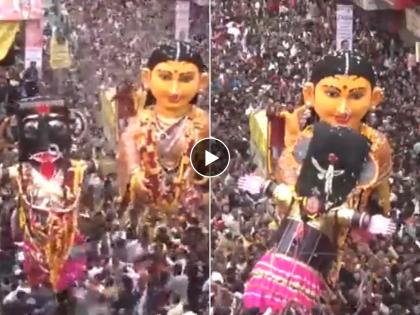Marbat Festival 2024: Celebrations Underway in Nagpur; Know All About Pili Marbat and Kali Marbat
By Lokmat English Desk | Updated: September 3, 2024 14:33 IST2024-09-03T14:05:20+5:302024-09-03T14:33:33+5:30
The Marbat festival, a centuries-old tradition, is currently being celebrated in Nagpur, Maharashtra. The city buzzes with festivities, including ...

Marbat Festival 2024: Celebrations Underway in Nagpur; Know All About Pili Marbat and Kali Marbat
The Marbat festival, a centuries-old tradition, is currently being celebrated in Nagpur, Maharashtra. The city buzzes with festivities, including a grand procession featuring Pili Marbat and Kali Marbat effigies, which attracts large crowds every year.
The tradition of taking out a Marbat procession on the second day of Pola has been observed for many years and is performed annually on this day. Marbat and Badgya are considered symbols of evil, which is why this festival is celebrated. The tradition continues through generations of artisans who craft the Marbat effigies, with black and yellow Marbats, known as Pili and Kali Marbats, still being made today.
Marbat Festival Celebrations Underway in Nagpur
#WATCH | Maharashtra: Marbat festival celebrations underway in Nagpur. This festival is celebrated to keep away evil spirits. pic.twitter.com/EktL8AC5pR
— ANI (@ANI) September 3, 2024
Pili Marbat is a tall effigy, standing 18 to 20 feet high, crafted by the Tarhane Teli community in Nagpur. The Kali Marbat, standing 14 feet tall, is constructed by the Kali Marbat Utsav Committee at Nehru Putla Chowk. Both effigies are worshipped for four days before being taken out in a procession on September 3 every year.
The tradition of creating the yellow Marbat began in 1885 to combat the spread of diseases in the city. At the time, a wave of illnesses had swept through Nagpur, and it was believed that building a Marbat could provide relief from these diseases.
The history of the black Marbat is also deeply rooted, with the tradition dating back 131 years. In 1881, a woman named Bakabaai from the Bhosale royal family of Nagpur rebelled and joined forces with the British, leading to misfortune for the Bhosale family. The Kali Marbat procession began as a protest against this betrayal.
On the day of the festival, the Marbat effigies are prepared and taken out in a procession. Following this, they are traditionally taken outside the city and burned, symbolizing the end of all evils, diseases, and bad practices. It is said that Kali Marbat represents Putana Rakshasi, the sister of Ravana from the Mahabharata era. After being killed by Lord Krishna, the people of Gokul took the effigy of Kali Marbat out of the village and burned it. This act is believed to cleanse the village of all evil and bad practices, a tradition that continues to this day.
Open in app